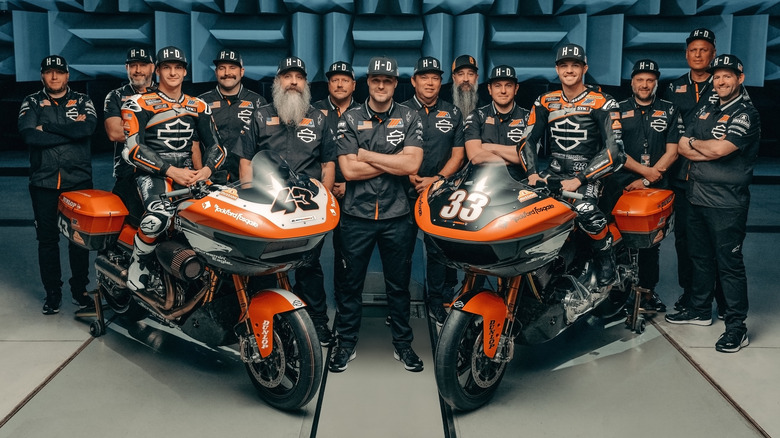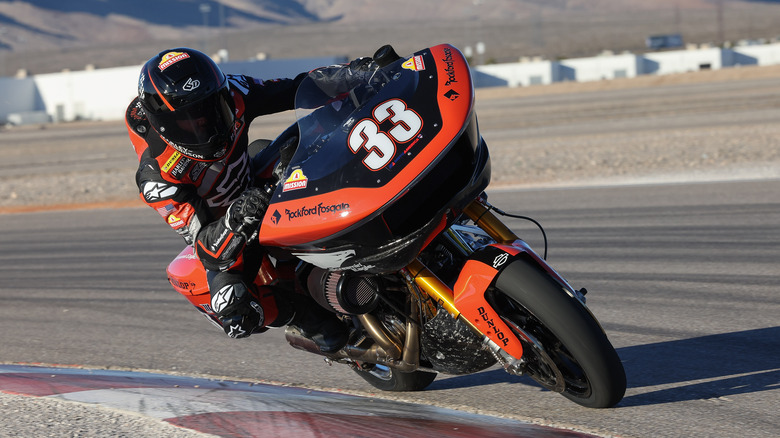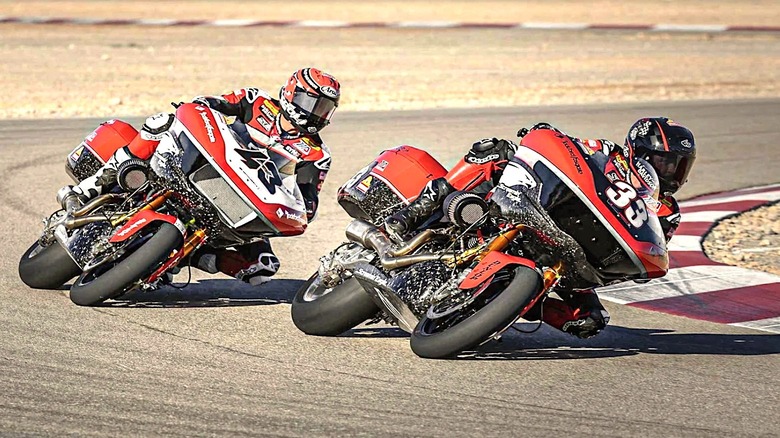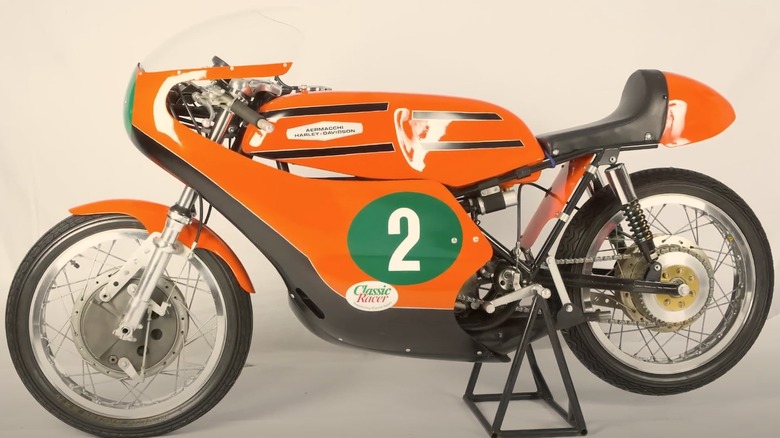Here's How Harley-Davidson's Race Team Mods Its Motorcycles To Win
Harley-Davidson is arguably the most recognizable motorcycle brand in North America, and among the most famous in the world. The company is known for building some of the best cruisers, choppers, and touring bikes to hit the road over its 120 years of history, and was also one of the first American motorcycle brands to take its talents to the race track.
The Milwaukee-based motorcycle manufacturer enjoyed an unparalleled level of success on flat track, most prominently with its record-breaking XR750 build, which remains one of the most celebrated and collectible bikes in the company's iconic line up. These days, Harley-Davidson's Factory Race Team is a force in MotoAmerica where it sends race-modified versions of its legendary Road Glide build to the tracks. These bikes compete in the touring class platform, dubbed the Mission King of the Baggers, which, while relatively new on the circuit, has proven exceedingly popular with race fans enjoying the sight of the souped-up Harley-Davidson and Indian bikes — complete with saddle-bags — burning up the track at incredibly high speeds.
Harley-Davidson is having a successful run on the KOB circuit
MotoAmerica is the premiere racing circuit in North America, and a proving ground for riders looking to make the jump to the prestigious MotoGP arena. The baggers have become so popular in the last few years that a Mission King of the Baggers race recently featured on the weekend schedule at the Circuit of the Americas track in Austin, Texas as support for the world's elite racing teams in MotoGP. Bikes adorned in Harley-Davidson's orange and black livery impressed, with the team's Kyle Wyman not only winning one of the two races, but setting a new class track record in the process.
Harley-Davidson's success in that race was hardly a surprise as its bikes and riders have finished first or second place in the championship for the last three years, with rider Kyle Wyman winning the most races in the circuit's history over that span. As of the time of writing, Wyman and his modified Road Glide V-Twin continue to lead the King of the Baggers in points for 2024, and may well bring another title home for the Harley-Davidson Factory Race Team.
These race modified baggers are tricked out and then some
The souped-up Harley-Davidson Road Glides regularly push north of 180 mph on the track, and boast horsepower in the ballpark of 185. That is a dramatic difference from the everyday Road Glide you'll find on the showroom floor at your local Harley dealer. Here's how the company's factory race team gets the bikes race ready.
The first difference you'll likely notice from the stock Harley-Davidson Road Glide is the fairing, with the race-ready bikes fronting the sleek new shark nose design that may soon feature on factory builds. Like those production models, however, the body panels for race prepared Road Glides are also made from forged carbon fiber, helping them stay lighter on the track without losing any toughness. As for the Road Glide's credentials, those impressive top speeds are possible thanks to modified Harley-Davidson's Screamin' Eagle Milwaukee-Eight 131 Performance Crate Engines, which power each bike the factory race team puts on the track.
According to Harley-Davidson, its track modified Road Glides also boast upgraded suspension components with Screamin' Eagle/Öhlins Remote Reservoir rear shocks, competition Screamin' Eagle exhausts, upgraded Brembo Racing braking systems, and Marchesini wheels, along with other premium Harley-Davidson racing components produced by Protolabs.
Harley-Davidson was once a winner on the Grand Prix circuit
Preceding Harley-Davidson's modified Road Glides chalking up wins and track records in the King of the Baggers, bikes bearing the company's name could regularly be found on the Grand Prix circuit throughout the 1960s and 1970s, and often in the winner's circle.
Those winning bikes were, of course, also fronting the name of the famed Italian motorcycle manufacturer Aermacchi, whom Harley-Davidson had purchased — half in 1960, and the other half by then owner AMF in 1972. The move was reportedly made as Harley bosses were looking for a European partner to help them develop small displacement builds. Finding such a partner in Aermacchi, the two companies also decided to focus engineering talent on the European racing scene, with the Italian manufacturer essentially building race-ready bikes with financial backing from Harley-Davidson.
Bikes boasting the Aermacchi Harley-Davidson badge were regular fixtures in 250cc and 350cc Grand Prix races of that era, with Renzo Pasolini putting the team on the map by finishing third place in the 350cc standings in 1966. The racing team really came into its own in the 1970s, when Walter Villa rode an Aermacchi Harley-Davidson build to 250cc championships in 1974, '75, and '76, while also taking home the 350cc title in '76. Unfortunately, financial struggles would plague Harley-Davidson throughout the late '70s and '80s, forcing the company to pull out of the Grand Prix racing arena altogether.



